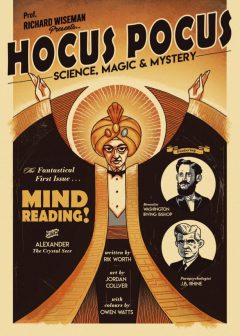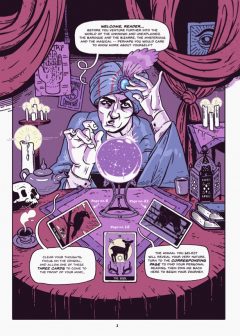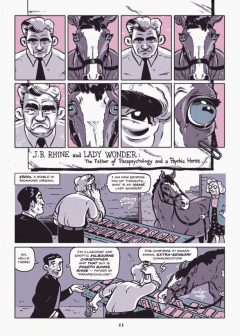“If we get them to change their entire world view that’s a bonus, but I’m mostly here for the gags!” we talk to Hocus Pocus creators Rik Worth and Jordan Collver about the power of comics
After having our mind blown by the discover of the fantastic Hocus Pocus from writer Rik Worth and artist Jordan Collver, we knew that we had to find out more and so asked Rik and Jordan to reveal some of their mystical secrets:
 Your new series Hocus Pocus looks at the history of parapsychology. Can you tell us a bit about the inspiration for the comic and why you decided to make it into a comic? What’s your background in comics and also para-psychology?
Your new series Hocus Pocus looks at the history of parapsychology. Can you tell us a bit about the inspiration for the comic and why you decided to make it into a comic? What’s your background in comics and also para-psychology?
Jordan Collver: Rik and I have been making comics together for over a decade and parapsychology just so happens to be one of the many unusual interests we both share, so getting to work on this project with Richard Wiseman is a perfect fit for us.
As a science communicator, I’m particularly interested in using comics to talk about science and I’ve previously done some research into the people who make such comics – and now I’m one of them!
Rik Worth: We started back at University with a little strip which was nominated for an Eagle Award. The awards went under that year which we can only assume is our fault, but then we were on a roll and started Ladies and Gentlemen, a small press adventure book. Since then we’ve made a bunch of short comics and spec work.
I’m always been fascinated by why people believe the things they do. Magic and the paranormal, seem to me to be exploring that area but with different approaches and both fields are full of oddballs so it seems perfect for comics. We actually started working on a graphic novel exploring belief and science from a more narrative perspective, looking at Houdini and Arthur Conan Doyle (you can read a test preview here: https://www.coroflot.com/jordancollver/A-Certain-Symmetry-comic) so this became a natural extension of that research process.
You have Professor Richard Wiseman (a psychology professor who has worked with Derren Brown) credited as a technical consultant, how involved was he in the creative process? And what did he bring to the books?
JC: The whole thing was his idea! We’d had the privilege of working with him in the past on a few small projects as part of his Quirkology YouTube channel (https://www.coroflot.com/jordancollver/Quirkology) and he approached us to see if we’d be interested in working on a series of comics about the history and psychology of magic and the paranormal – we jumped at the opportunity.
 Richard provided the overall shape and direction of the series, including what “magical” elements he wanted to include, and then it was up to Rik to do the research and weave it together into a fun, cohesive narrative for me to draw. Richard’s practical guidance on how to visually incorporate and execute the practical elements of the tricks has been invaluable. It’s been really enjoyable working with an actual member of the Magic Circle (!) lending his expertise in the arcane knowledge of magic (and the psychology behind it).
Richard provided the overall shape and direction of the series, including what “magical” elements he wanted to include, and then it was up to Rik to do the research and weave it together into a fun, cohesive narrative for me to draw. Richard’s practical guidance on how to visually incorporate and execute the practical elements of the tricks has been invaluable. It’s been really enjoyable working with an actual member of the Magic Circle (!) lending his expertise in the arcane knowledge of magic (and the psychology behind it).
RW: I had actually contacted Richard when I was researching the Houdini/Doyle book because I needed to know how a certain magic trick was done. He has never told me to this day but he’s very good at nodding in the direction you might discover such arcane knowledge.
With Hocus Pocus, he was invaluable when it came to working out the reality of the events. The crazy thing about magic history is quite a lot of it has been documented if you know where to look, but some of it is still speculation. When it came to the point of “we’re just not sure”, Richard was great at presenting possibilities. He also pushed us to include more and more on an interactive level while, very sagely, helped me to wind it in when the farcical elements were getting too wild.
We love the way you hide little tricks and interactive elements into the story. Was this always part of the plan for the book in order to give it an added layer of depth and make it more than just a look at parapsychologists?
JC: Yes, this was one of Richard’s main goals from the outset, and has been a fun challenge for Rik and I. We worked on a couple of trick comics with Richard before where you needed to fold or cut the page a certain way for the story to play out, but Hocus Pocus expands on this idea and applies it to a longer format.
The visual language of comics can be a valuable educational tool in explaining often complex information, and it’s been great to see a rise in non-fiction comics about science and history over the past decade. Comics is already an “active” medium involving the interpretation of the reader as they navigate the page, and we’re hoping to take advantage of this quality to do things with Hocus Pocus that people may not have seen before or realise that comics are capable of (or maybe are even uniquely capable of).
RW: Absolutely. As fun as it is to play around in history, science and the paranormal, I think of Jordan and myself as comic creators first so, adding these extra layers was a way of testing what we could do in the medium while still keeping the stories held together.
Stage magic and science can be boring if you’re just going for a straight explanation so the one-two punch of the cartoon and the interactivity was always a consideration to draw the readers into the stories.
 How did you choose which characters to feature this first issue and are there lots of other larger than life characters who you can feature for future issues? Who were your favourites to write and are there any you are looking forward to covering?
How did you choose which characters to feature this first issue and are there lots of other larger than life characters who you can feature for future issues? Who were your favourites to write and are there any you are looking forward to covering?
RW: Each issue has a loose theme so the characters ended up being pooled together naturally. We had a huge list of stories and themes we wanted to look at so it was just a case of working through them.
Aside from the Laurel and Hardy homages, I really enjoy writing the silent characters and the animals – there are many more magical animals to come. I know that probably sounds lazy as they have very little dialogue but I loved having to visualise their actions in order to communicate the story. Lady Wonder, the psychic horse, becoming increasingly panicked under scrutiny was so fun to imagine. Luckily JC is very good a drawing nervous horses too.
I’m really looking forward to the Rose Mackenberg story. She was Houdini’s chief spy and a master of disguise. I think her story is going to be really fun.
JC: It was fun to be able to include Arthur Conan Doyle, who I’ve already become quite familiar with drawing through another comic project we’ve been developing over the past few years about Doyle’s friendship with Houdini. It turns out the history of magic is filled with an amazing cast of real characters that lend themselves readily to cartooning. I look forward to drawing them!
The artwork is incredible from Jordan and Owen. Did the style of the book and the colours evolve out of the types of story and time periods of the stories you wanted to tell? Was it important for you to give the book a very distinct visual style to help make it stand out and also fit in with the stories you were telling?
JC: Thank you very much! I worked closely with Owen on the colours, bringing his expert eye for colour layouts. We wanted each story should have it’s own minimal but distinctive colour palette – be that a contemporary play on sepia-tone Victorian photos for the story about Washington Irving Bishop, for example, or trying to evoke the mood of classic Batman or Dick Tracy strips when Alexander is being interrogated by the FBI.
 Rather than try to fit in on the shelf alongside standard UK or US comic sized books like we normally do, we chose to print Hocus Pocus at a larger size and on heavier paper as a “deluxe” format homage to old Tales of Adventure-style magazines.
Rather than try to fit in on the shelf alongside standard UK or US comic sized books like we normally do, we chose to print Hocus Pocus at a larger size and on heavier paper as a “deluxe” format homage to old Tales of Adventure-style magazines.
For the illustrations themselves, I’ve been increasingly trying to tap into the wonderful tradition of cartooning to lend a levity, playfulness, and clarity which is perfect for the combination of storytelling and communicating information we’re going for.
RW: Obviously I’m very lucky to work with Jordan and Owen. I’ve watched JC’s style progress over a decade of making funny books together and it think this cartooning style, rather than his previous illustrative style, allowed us to be sillier in places. It sets up the reality as an almost preposterous place which lets us slip into the space between lecturing and laughing these people.
You are releasing the book as a free digital download and then a paid for print copy, what made you choose this way round rather than release via a publisher or crowd fund it etc?
RW: The book is part of a wider scheme to communicate scientific thinking, so from day one, we wanted it to be accessible to everyone for free. That said, we both love the physicality of comics and the printing quality adds a texture to Jordan’s art which takes it to another level. Also, some of the tricks in the book don’t have the same impact on a screen as they do in the real world.
Working with magicians, we had to keep a lot of the book under-wrap before release so a crowdfund would have been very underwhelming. Maybe the mystery would have added to it. Depending on how well this book goes, we’re already talking about our next project which we may want to crowdfund, but JC has a stack of pages to draw before then.
JC: We’d ultimately love to get the series published if there was an interest, but in the meantime we felt from the outset that it was important to make it available for free as part of our educational aspirations for the series.
 If people enjoy this book is there any further reading you would recommend? And what do you hope people get out of this book?
If people enjoy this book is there any further reading you would recommend? And what do you hope people get out of this book?
RW: If you’re interested in non-fiction comics I’d check out Fred Van Lente and Ryan Dunlavey’s work like Action Philosophers and Comic Book History of Comics. For magic/skeptic history, of course, Richard’s book Para-normality is great and magic history Jim Steinmeyer has a few really great and accessible books covering similar territory. My warning would be, ultimately, sometimes the secrets aren’t as good as the tricks. So, spoiler warning I guess. And if you want to see someone integrating comics with puzzles, check out Jack Fallow’s Cryptograms.
Mostly, I just want people to have a smile on their face. If we get them to change their entire world view and subsequently commit themselves to examining their minds with fresh, analytic eyes, that’s a bonus, but I’m mostly here for the gags.
JC: If people came away from reading the book knowing a bit about how science works in relation to the mysterious and paranormal (and the noble tradition of skepticism and critical thinking prevalent in stage magic throughout its zany history) and had fun along the way, then I’d be happy. Happier still if they gain a greater appreciation for the versatility of the comics medium and ask themselves… what else can comics do?
And finally, are there any hidden detail in the book which people should keep an eye out for, that they might not notice on a first or second reading?
JC: Several magicians (past and present) make cameos, including Derren Brown and his dog Doodle, and we’ve peppered the book with other easter eggs that we’ll leave to readers to look for.
RW: There are a few nods to the comic’s world and to our previous work in there. The proto-Zener designs have a few references. You might recognise one or two of them. Jordan also cameos in the comic in a very unflattering way which makes me laugh when I see how he’s draw himself.
JC: In addition to the tricks presented in the stories themselves, we actually designed the comic with more secret elements so magicians can use it as an on-stage prop to read people’s minds. That was fun to try to figure out how to embed those in the comic without casual readers noticing. We’re taking this idea even further with the second “special” issue, on which we’re collaborating with a magician who will feature it as a central part of a performance in front of a live audience.
You can find out more about Hocus Pocus at www.hocuspocuscomic.com where you can download a digital copy issue #1 for free or order the print copy or follow the team on twitter @RikWorth @JordanCollver @RichardWiseman @owenwattsdraws



October 9, 2025 @ 5:10 am
You’re so awesome! I don’t believe I have read a single thing like that before. So great to find someone with some original thoughts on this topic. Really.. thank you for starting this up. This website is something that is needed on the internet, someone with a little originality! Catch bbc persian live radio — in‑depth reports and documentaries. live bulletins and interviews. analysis programs, feature stories. reliable HD stream on any device.
November 1, 2025 @ 9:40 pm
Your article helped me a lot, is there any more related content? Thanks!
December 20, 2025 @ 1:26 am
Ellis Island ist 4,5 km vom Hotel entfernt,
während National September 11 Memorial und Museum 3 km vom
Grundstück entfernt ist. Charles Memorial Park ist 3,5 km und Phil “Scooter” Rizzuto
Park ist 3,2 km von der Unterkunft entfernt. Das 3-Sterne Hampton Inn NY-JFK New York liegt im Stadtteil Queens und verfügt
über eine Bibliothek und einen Kamin.
Von den lebhaften Casinos in der Innenstadt bis zu
den exklusiven Resorts in den Außenbezirken – in New York gibt es für jeden Geschmack das passende Casino-Hotel.
New York ist bekannt für seine Vielfalt und bietet auch eine beeindruckende Auswahl an erstklassigen Casino-Hotels, die sowohl Luxus als auch Unterhaltung bieten. Das
Hotel bietet Ihnen den Aufenthalt im Stadtteil Washington Heights.
Befindet sich in New York und bietet ein Kasino, einen Nachtclub und einen Friseurladen.
Die Themenhotels in diesem Teil der Stadt leiden unter langen Schlangen zu den Stoßzeiten beim Einchecken, aber der Kundenservice ist
zum Glück höflicher als im echten New York und alle scheinen zufrieden zu sein. Das New York-New
York Hotel & Casino ist ein weiteres der beliebtesten Themenhotels in Las Vegas.
Die japanische Firma Universal Distributing besaß das
Grundstück und hatte ein Joint Venture mit den Promus
Companies zum Bau eines Hotelcasinos diskutiert, konnte aber
keine Einigung erzielen.
References:
https://online-spielhallen.de/mr-bet-casino-bonus-codes-ihr-weg-zu-extra-spielspas/
December 20, 2025 @ 10:09 am
Dazu kommen noch regelmäßig neue Aktionen und Freispiele, damit es nie
langweilig wird. Ein Spieler meinte, dass er durch die vielen Freispiele und Cashback-Angebote immer etwas zusätzlich herausholen konnte, selbst wenn das Glück mal nicht
auf seiner Seite war. Die Plattform bietet verschiedene Tools, um dir zu helfen,
dein Spielverhalten zu kontrollieren.
Wir empfehlen, verantwortungsbewusst zu spielen und sich der möglichen Konsequenzen bewusst zu sein. Die posido casino
app ist für iOS und Android verfügbar. Die posido casino auszahlung
ist so flexibel, dass du sicher das Passende findest. Viele Casinos bieten sowas nicht an, aber hier hast du die Möglichkeit, schnell und anonym
zu spielen. Das sorgt für diese extra Portion Casino-Atmosphäre, die dir das
Gefühl gibt, nicht allein zu spielen.
References:
https://online-spielhallen.de/robocat-casino-auszahlung-ihr-umfassender-leitfaden/